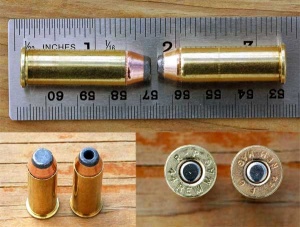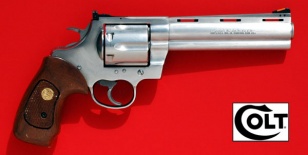.44 Magnum
| .44 Magnum | |||||||||||||||||||
|---|---|---|---|---|---|---|---|---|---|---|---|---|---|---|---|---|---|---|---|

| |||||||||||||||||||
| .44 Magnum cartridge | |||||||||||||||||||
| Type | Handgun/Revolver/Rifle | ||||||||||||||||||
| Country of Origin | United States | ||||||||||||||||||
| Specifications | |||||||||||||||||||
| Parent Case | .44 Special | ||||||||||||||||||
| Case Type | straight, rimmed | ||||||||||||||||||
| Bullet Ø | .429 in (10.9 mm) | ||||||||||||||||||
| Neck Ø | .457 in (11.6 mm) | ||||||||||||||||||
| Base Ø | .457 in (11.6 mm) | ||||||||||||||||||
| Rim Ø | .514 in (13.1 mm) | ||||||||||||||||||
| Rim Thickness | .060 in (1.5 mm) | ||||||||||||||||||
| Case Length | 1.285 in (32.6 mm) | ||||||||||||||||||
| Full Length | 1.61 in (41 mm) | ||||||||||||||||||
| Rifling twist | 1-38 | ||||||||||||||||||
| Primer | Large pistol | ||||||||||||||||||
| Production & Service | |||||||||||||||||||
| Designer | Elmer Keith | ||||||||||||||||||
| Design Date | 1950s | ||||||||||||||||||
| Manufacturer | everybody | ||||||||||||||||||
| Production Dates | 1955-Present | ||||||||||||||||||
| Ballistic Performance Sampling | |||||||||||||||||||
| |||||||||||||||||||
The .44 Remington Magnum', or simply .44 Magnum,' is a large-bore cartridge originally designed for revolvers; after introduction, it was quickly adopted for carbines and rifles. Despite the ".44" designation, all guns chambered for the .44 Magnum case, and its parent case, the .44 Special, use bullets of approximately 0.429in. (10.9mm) in diameter.[4]
The .44 Magnum is based on a lengthened .44 Special case, loaded to higher pressures for greater energy. Soon after its introduction, the .44 Magnum was eclipsed in power by the .454 Casull cartridge, and others, nevertheless, it remains the most popular large-bore magnum cartridge. When loaded to its maximum and with heavy, deeply penetrating bullets, the .44 Magnum cartridge is suitable for hunting game to the size of black bear — though at the cost of much recoil and muzzle flash, however, low-velocity loads and light bullets have less recoil and are accurate to shoot.
Contents |
Origin
The .44 Magnum cartridge was the end result of years of "souped-up" handloading of the .44 Special. The .44 Special, and other big bore handgun cartridges were being loaded with heavy bullets pushed at higher than normal velocities for better hunting performance. One of these handloaders was Elmer Keith, a famous writer and outdoorsman of the 20th Century.
Elmer Keith settled on the .44 Special cartridge as the basis for his experimentation, rather than the larger .45 Colt. At the time the selection of .44 caliber projectiles for handloaders was better, and the .44 Special case was smaller in diameter than the .45 Colt case—in revolvers of the same size, this meant the .44 caliber revolvers had thicker, and therefore stronger, cylinder walls than the .45. This allowed higher pressures to be used without risk of a burst cylinder.
Mr. Keith encouraged Smith & Wesson and Remington to produce a commercial version of this new high pressure loading, and revolvers chambered for it. While S&W produced the first prototype revolver chambered in .44 Magnum, the famous Model 29, Sturm, Ruger actually beat S&W to market by several months in 1956 with a .44 Magnum version of the single action Blackhawk revolver. The exact reason for this is lost in legend; one version says a Ruger employee found a cartridge case marked ".44 Remington Magnum" and took it to Bill Ruger, while another says a Remington employee provided Ruger with early samples of the ammunition.
The .44 Magnum case is slightly longer than the .44 Special case, not because of the need for more room for propellant, but to prevent the far higher pressure cartridge from being chambered in older, weaker .44 Special firearms.
The .44 Magnum was an immediate success, and the direct descendants of the S&W Model 29 and the .44 Magnum Ruger Blackhawks are still in production, and have been joined by numerous other makes and models of .44 Magnum revolvers and even a few semi-automatic pistols, such as the Desert Eagle. Ruger introduced its first long gun, a semi-automatic carbine chambered for the .44 Magnum, in 1959, and Marlin followed soon after with a lever action model 1894 in .44 Magnum. Having a carbine and a handgun chambered in the same caliber is an old tradition; the .44-40 Winchester was introduced by Winchester in a lever action in 1873, and Colt followed in 1878 with a revolver chambered in the same caliber. .38-40 Winchester and .32-20 Winchester were also available chambered in both carbines and revolvers, allowing the shooter to only need one type of ammunition for both firearms.
While modern steels and manufacturing techniques have allowed even stronger cylinders, leading to larger and more powerful cartridges such as the .454 Casull and .480 Ruger in revolvers the same size as a .44 Magnum, the .44 Magnum is still considered a top choice today. In 2006, to commemorate the 50th anniversary of the .44 Magnum, Ruger introduced a special 50th anniversary Blackhawk revolver, in the "Flattop" style.
Technical specifications

The .44 Magnum delivers a large, heavy bullet with high velocity for a handgun. In its full-powered form, it produces too much recoil and muzzle blast to be suitable for a police weapon, and is likely not very suitable for shooters of smaller build or with small hands.
Some gun styles are more comfortable to use when shooting this caliber. Many shooters find the rounded grip shape of the single action better for handling heavy recoil than the grip shape of double-action revolvers, which have a shoulder on top of the grip. Many shooters, including Keith, consider the ideal type of grip for heavy recoiling guns to be the longer "Bisley" style single action grip, and it can be found on single actions from Ruger (models marked "Bisley") and Freedom Arms, as well as many custom makers.[5]
Dual-purpose use

The dual-purpose concept has been popular since the Old West, with cartridges like such as the .44-40 Winchester, whose "High-Speed" rifle loadings were precursor magnum loads; other dual-use rounds were the .32-20 Winchester and the .38-40 Winchester.
Some past dual-purpose handgun/rifle cartridges, like the .44-40 Winchester, gave their manufacturers trouble when people loaded the "High-Speed" versions designed for rifles into handguns. Since the .44 Magnum was designed from the start as a revolver cartridge, such issues are moot, and SAAMI compliant ammunition should fire from any handguns or rifles chambered for the .44 Magnum.
As a rifle or carbine cartridge the .44 Magnum is powerful enough for medium sized game, yet fits easily into a compact, lightweight package. The lever-action Marlin Model 1894 and semiautomatic Ruger 99/44 "Deerfield" carbines, with 20-inch (510 mm) and 18½-inch barrels respectively, are examples of carbines currently available in this caliber. With significantly longer barrels than revolvers, carbines will generate quite a bit more velocity than a revolver loaded with the same ammunition. Tests with various ammunition in the Ruger Deerfield yielded a 100 yard (90 m) velocity of over 1,300 ft/s (400 m/s) with a 240-grain (16 g) bullet, comparable to the muzzle velocity out of a revolver.[6] Aggressive loads using slow burning powders maximize performance in both short and long barrels, with one published load generating 1,500 ft/s (460 m/s) from a revolver, and 1,625 ft/s (495 m/s) from a carbine with a 240-grain (16 g) bullet.[7]
Suitable game
The .44 Magnum is well suited for game up to brown bear size; with precise shot placement and deep penetrating cartridges it has even been used to take the largest of game, including Cape Buffalo; publisher Robert E. Petersen even took a record setting polar bear with a .44 Magnum.[8]
In addition to beating the ballistics of the old .44-40 rifle loads, long considered a top deer cartridge, the heavy, flat point bullets typically used in the .44 Magnum have an additional advantage. Tests performed where bullets are shot through light cover, intended to represent twigs and brush, have shown that the high velocity, light weight, thin jacketed, pointed bullets used by most hunting cartridges today are easily deflected by contact with the brush. The ideal bullets for penetrating brush with minimal deflection are heavy, flat point bullets at moderate velocities.[6]
Range
The accuracy of the .44 Magnum is very good, with models from Colt, Smith & Wesson, and Ruger producing bullet groups of 3 to 4 inches (7.5 to 10cm) at 50 yards, with most ammunition. [9] The limiting factor of the .44 Magnum cartridge is not terminal ballistics, because a heavy, non-expanding bullet at .44 Magnum velocities will shoot through large game such as elk and even bison. The limiting factor is the bullet's trajectory; the best hunting bullets are heavy, thus, relatively slow, meaning a significant drop-out of trajectory at ranges beyond 100 yards (90m); with a 50-yard zero, drop-out at 100 yards is about 2 inches (5cm), and drop-out at 150 yards (135m) is more than 8 inches (20cm); with a 100-yard zero, drop-out at 150 yards is more than 6 inches (15cm). [10] Experts recommend limiting hunting ranges to 100 yards (90m) when shooting .44 Magnum cartridges, less if practical accuracy requires it. [6][11]
.44 Magnum in popular culture
While the .44 Magnum was very popular among shooters for many years after its introduction, it didn't gain notice by the general public until 1971, when Clint Eastwood's character "Dirty" Harry Callahan described the .44 Magnum as the most powerful handgun in the world in the film Dirty Harry. While this was not strictly true in 1971 (the more powerful .454 Casull was announced in 1959, and was available in custom revolvers), it still caused prices of the Smith & Wesson Model 29 to skyrocket; demand far exceeded supply, and guns were selling for triple the normal retail price. This sudden surge in popularity elevated the .44 Magnum to "magical" levels, spawning a mythos, such as the (false) claim that the .44 Magnum could "put a bullet right through an engine block" – a claim made by the gun dealer character in the 1976 film Taxi Driver. The .44 Magnum continued to be associated with Dirty Harry's character, including the scene with Eastwood's famous line "Go ahead, make my day." in the 1983 film Sudden Impact.[12]
The .44 Magnum has fallen even further from the title of "most powerful" in recent years. Hunting and metallic silhouette handguns, such as the single shot Thompson Center Arms Contender and Encore, are often chambered for commercial rifle cartridges and wildcat cartridges such as those by J. D. Jones. These generate nearly triple the power of the .44 Magnum (the .35-06 JDJ generates over 3,400 ft·lbf (4,600 N·m). of energy from a 15" barrel), and still surpass even the modern .500 S&W Magnum in power.[13]
The .44 Magnum portrayed in Eastwood's Dirty Harry films was the inspiration for US Patent 5333531, issued to Roger Field for an improvement in revolvers by minimizing the cylinder gap in an economical way.
See also
- .445 SuperMag
- List of handgun cartridges
- List of rifle cartridges
- 10 mm caliber Other cartridges of similar size
- Colt Anaconda Revolver
- Taurus Raging Bull Revolver
References
- ↑ Remington Arms Co. ballistics table
- ↑ Wolf Gold Ammo
- ↑ Double Tap Ammo
- ↑ Lyman Reloading Handbook, 48th edition, 2002
- ↑ I LIKE SINGLE ACTIONS BECAUSE.... JOHN TAFFIN, Sixguns.com
- ↑ 6.0 6.1 6.2 Woods and Brush Rifles Chuck Hawks
- ↑ Accurate Arms, 21.3 grains of #9 and an IMI 240 grain JHP bullet; see rifle and handgun data.
- ↑ TAFFIN TESTS: THE .44 MAGNUM JOHN TAFFIN
- ↑ Stock Silhouette Revolvers: Anaconda Versus Redhawk July 1997 Performance Shooter, PS Staff
- ↑ Ballistics Results Remington
- ↑ Handgun Hunting Chuck Hawks
- ↑ AFI's list of 100 famous movie quotes American Film Institute
- ↑ COR-BON Hunter

